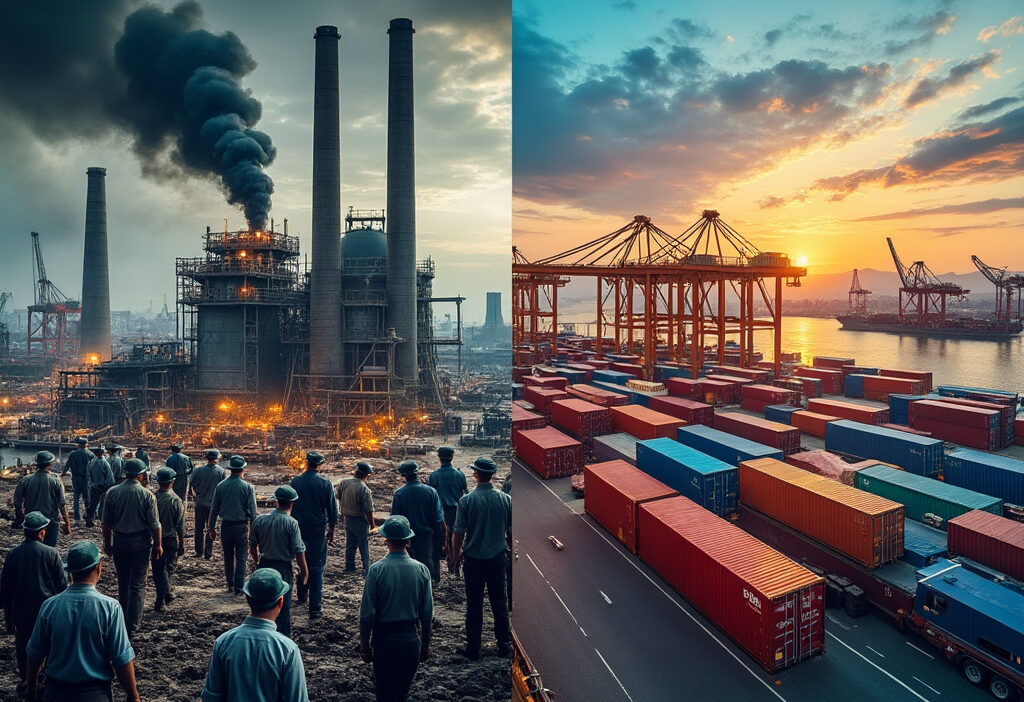Understanding Market Reactions to Tariffs
Tariffs have long been a tool for governments to protect domestic industries, but their impact on markets can be profound and far-reaching. From the Smoot–Hawley Tariff Act of 1930 to modern trade wars, tariffs can alter trade balances, provoke retaliatory measures, and influence global economic health. This article explores the nuanced reactions of markets to tariffs, offering insights into historical outcomes and current implications.
The Historical Context of Tariffs
Tariffs have long been used as instruments of economic policy, shaping trade dynamics and market reactions throughout history. One of the most infamous examples, the Smoot-Hawley Tariff Act of 1930, illustrates how tariffs can trigger widespread market volatility. By raising duties on over 20,000 imported goods, the U.S. aimed to protect domestic industries during the Great Depression. However, the act provoked retaliatory tariffs from trading partners, leading to a collapse in global trade by nearly 66% between 1929 and 1934. Stock markets reacted sharply, with the Dow Jones Industrial Average plummeting as investors anticipated prolonged economic stagnation.
Historical precedents show that tariffs often distort market efficiency. For instance, Britain’s Corn Laws in the 19th century artificially inflated grain prices, benefiting landowners but straining consumers and industrial workers. Similarly, the Chicken Tax of 1963, a U.S. tariff on light trucks, reshaped automotive markets by incentivizing domestic production while limiting competition. These cases reveal a pattern: tariffs initially buoy protected sectors but disrupt supply chains and erode consumer purchasing power. Markets typically respond with sell-offs in export-dependent industries and currency fluctuations as trade balances shift. The ripple effects underscore how tariffs, while politically appealing, often yield unintended economic consequences.
Mechanics of Tariffs and Their Immediate Effects
Tariffs function as a tax imposed on imported goods, directly raising their prices in the domestic market. When a government enacts a tariff, the immediate effect is an increase in the cost of foreign products, making them less competitive compared to domestically produced alternatives. This shift alters demand dynamics—consumers may pivot toward local goods, while foreign exporters face reduced sales unless they absorb the cost increase.
The mechanics of tariffs create ripple effects across supply chains. Importers either pass the added expense to consumers, leading to higher retail prices, or compress profit margins to maintain competitiveness. In either scenario, domestic industries benefiting from reduced foreign competition may see short-term gains, but downstream sectors reliant on imported inputs could face cost pressures.
Internationally, tariffs disrupt trade balances. Exporters hit by tariffs may retaliate, sparking trade wars that further distort markets. Currency valuations can also fluctuate as tariffs alter trade flows, impacting exchange rates. Historical precedents, like those discussed earlier, show how tariffs can trigger cascading economic consequences. The next section will explore how financial markets digest these policy shifts, often reacting with volatility to anticipated trade disruptions.
Market Reactions to Tariff Announcements
Financial markets often react swiftly and sharply to tariff announcements, reflecting investor sentiment about potential disruptions to trade flows and corporate profitability. Stock markets typically see sector-specific volatility, with industries directly affected by tariffs—such as automotive, steel, or technology—experiencing immediate price swings. For example, when the U.S. announced tariffs on Chinese goods in 2018, the S&P 500 dropped nearly 6% over the following month, while companies reliant on Chinese imports, like Apple and Caterpillar, saw significant declines. Conversely, domestic producers benefiting from protectionist measures, such as U.S. steelmakers, rallied.
Currency markets also react, as tariffs alter trade balances and expectations of monetary policy. The Chinese yuan depreciated by over 5% against the dollar in 2019 amid escalating U.S.-China trade tensions, reflecting fears of reduced exports. Similarly, the euro weakened when the EU threatened retaliatory tariffs on U.S. goods, signaling potential economic slowdowns.
Bond markets may see a flight to safety, with investors favoring Treasuries or gold amid uncertainty. In 2018, 10-year U.S. Treasury yields fell as trade war fears grew, highlighting risk aversion. These reactions underscore how tariffs disrupt not just trade but global capital flows, creating ripple effects across asset classes. The next chapter explores how retaliatory measures amplify these disruptions, leading to prolonged trade wars.
Retaliatory Tariffs and Trade Wars
When tariffs are imposed, affected nations often respond with retaliatory tariffs, escalating tensions into full-blown trade wars. Retaliatory measures aim to pressure the initiating country into reversing its policies but frequently lead to prolonged economic standoffs. Historically, the Smoot-Hawley Tariff Act of 1930 triggered global retaliation, deepening the Great Depression as trade volumes plummeted by nearly 66%. More recently, the 2018 U.S.-China trade war saw tit-for-tat tariffs on $450 billion worth of goods, disrupting global supply chains and dampening investor confidence.
Trade wars create long-term distortions in markets. Companies face uncertainty, delaying investments and shifting production to avoid tariffs, often at higher costs. For example, the U.S.-EU steel tariffs in 2002 led to temporary protections for domestic producers but ultimately raised input costs for manufacturers, hurting competitiveness. Similarly, China’s retaliatory tariffs on U.S. agricultural goods forced American farmers to seek alternative markets, with lasting sectoral damage.
The ripple effects extend beyond direct participants. Third-party nations often exploit trade wars by capturing market share, as seen when Brazil and Australia expanded soybean exports to China during the U.S.-China dispute. However, such gains are typically short-lived, as trade wars reduce overall global demand, stifling growth across interconnected economies.
Impact on Domestic Industries
Tariffs have a dual-edged impact on domestic industries, offering short-term protection while often imposing long-term costs. On one hand, tariffs shield local producers from foreign competition, allowing them to maintain or increase market share. For example, the U.S. steel tariffs imposed in 2018 temporarily boosted domestic production by over 10%, safeguarding jobs in the industry. However, this protectionism comes at a price. Import-dependent industries, such as automotive manufacturing, face higher input costs, squeezing profit margins and forcing price hikes onto consumers.
Case studies reveal stark contrasts. Brazil’s tariffs on imported electronics in the 2010s fostered local assembly plants but stifled innovation due to reduced competition. Conversely, Australia’s removal of car tariffs in the 2000s led to industry decline but lowered consumer prices. The key takeaway is that tariffs often redistribute costs rather than eliminate them—benefiting some sectors while burdening others.
The ripple effects extend beyond immediate industries. As tariffs disrupt supply chains (a topic explored in the next chapter), domestic manufacturers relying on global inputs face production delays and inflated costs. This interconnectedness underscores how tariffs, while politically appealing, rarely deliver unambiguous economic wins.
Global Supply Chain Disruptions
Tariffs disrupt global supply chains by introducing artificial barriers to trade, forcing companies to reconfigure production networks and sourcing strategies. Increased costs ripple through industries as businesses absorb or pass on higher import expenses, while lead times stretch due to delays at customs or the need to find alternative suppliers. Industries reliant on just-in-time manufacturing, such as automotive and electronics, are particularly vulnerable, as even minor disruptions can halt production lines.
The reshoring of production, often cited as a tariff benefit, is rarely seamless. Many firms lack domestic suppliers capable of matching cost or quality, leading to fragmented supply chains. For example, U.S. steel tariffs in 2018 forced manufacturers to pay premiums for domestic steel, but shortages persisted, delaying projects in construction and machinery sectors.
Emerging markets face acute risks, as tariffs on intermediate goods—like Chinese semiconductors—raise costs for downstream industries globally. The resulting inefficiencies often outweigh any protectionist gains, reinforcing how tariffs distort rather than stabilize supply chains. These disruptions set the stage for broader inflationary pressures, as explored in the next chapter.
Consumer Price Inflation
Tariffs directly influence consumer price inflation by increasing the cost of imported goods, which often leads to higher prices for end consumers. When tariffs are imposed, importers face higher expenses, which they typically pass on to retailers. Retailers, in turn, raise prices to maintain profit margins, creating a ripple effect throughout the economy. This phenomenon is particularly evident in industries reliant on imported raw materials or finished goods, such as electronics, automotive, and apparel.
The extent of price inflation depends on several factors, including the elasticity of demand for the taxed goods and the availability of domestic substitutes. Inelastic goods—those with few alternatives—see sharper price hikes, as consumers have little choice but to absorb the added costs. For example, tariffs on essential medical equipment during trade disputes have led to significant price surges, disproportionately affecting healthcare systems.
Historical examples, like the U.S.-China trade war, demonstrate how prolonged tariffs can embed inflationary pressures into the economy. While some industries attempt to mitigate costs by shifting supply chains—as discussed in the previous chapter—these adjustments often take time, leaving consumers exposed to short-term price spikes. The resulting inflation can erode purchasing power, fueling broader economic debates, as will be explored in the next chapter on political ramifications.
Political and Diplomatic Ramifications
Tariffs often serve as political tools, sparking diplomatic friction and reshaping international alliances. When one nation imposes tariffs, retaliatory measures frequently follow, escalating tensions and undermining decades of trade cooperation. The U.S.-China trade war exemplifies this, where tit-for-tat tariffs strained relations, disrupted supply chains, and fueled geopolitical rivalries beyond economics. Such conflicts can spill into security and technology disputes, as seen in Huawei sanctions and semiconductor restrictions.
Domestically, tariffs ignite fierce policy debates. Proponents argue they protect industries and jobs, while opponents warn of trade wars and inefficiencies. In the U.S., steel and aluminum tariffs divided policymakers, with some advocating for protectionism and others emphasizing free trade’s benefits. Similarly, the EU’s carbon border tax has sparked contention, blending environmental goals with trade protectionism.
Recent geopolitical tensions, like those between Russia and Western nations, show how tariffs can weaponize trade. Sanctions and import bans disrupt markets but also harden diplomatic stances, making negotiations harder. These measures often have unintended consequences, such as pushing targeted nations toward alternative alliances—like Russia deepening ties with China. The political fallout from tariffs extends far beyond economics, reshaping global power dynamics.
Long-Term Economic Consequences
The long-term economic consequences of tariffs extend far beyond immediate price hikes, reshaping trade dynamics and growth trajectories. Economic models, such as those from the World Bank and IMF, consistently show that sustained tariffs reduce global trade volumes by distorting comparative advantages and discouraging cross-border investment. Historical data underscores this: the Smoot-Hawley Tariff Act of 1930 exacerbated the Great Depression by shrinking global trade by nearly 66% between 1929 and 1934. Similarly, recent U.S.-China tariffs lowered bilateral trade by over 15% within two years, with spillover effects dampening global GDP growth by an estimated 0.4%.
Tariffs also trigger efficiency losses, as protected domestic industries often lag in innovation due to reduced competition. Computable General Equilibrium (CGE) models reveal that long-term tariffs can suppress GDP growth by up to 0.5% annually in affected economies. Additionally, retaliatory measures create a negative feedback loop, further contracting trade networks. For instance, the EU’s retaliatory tariffs on U.S. agricultural goods disrupted $3.2 billion in exports, illustrating how tit-for-tat policies compound economic damage.
While tariffs may offer short-term protection, their legacy is often slower growth, fragmented supply chains, and diminished productivity—a cautionary tale for policymakers weighing isolationist trade strategies.
Strategies for Mitigating Negative Impacts
To mitigate the adverse effects of tariffs, businesses and governments must adopt proactive strategies that address vulnerabilities while capitalizing on new opportunities. Diversification of supply chains is a critical approach for businesses. Overreliance on a single market exposes companies to tariff-induced disruptions. By sourcing materials from multiple regions—such as shifting production to Southeast Asia or Latin America—firms can reduce dependency on tariff-heavy trade routes. Advanced analytics and AI-driven logistics platforms can optimize this transition, identifying cost-effective alternatives without compromising quality.
Governments play a pivotal role by negotiating trade agreements that offset tariff burdens. Bilateral or multilateral deals, like the USMCA or RCEP, can lower trade barriers and stabilize market access. Historical precedents, such as the EU’s response to U.S. steel tariffs in 2018, demonstrate how targeted negotiations can soften economic blows. Additionally, investing in domestic innovation—through subsidies or R&D tax incentives—can enhance competitiveness, reducing reliance on imports vulnerable to tariffs.
For businesses, hedging strategies in financial markets, such as futures contracts, can lock in prices for raw materials, insulating against tariff-driven cost fluctuations. Combining these measures fosters resilience, ensuring sustained growth despite protectionist policies.

Conclusions
Tariffs are a double-edged sword, offering protection to domestic industries while risking broader economic disruptions. Historical precedents like the Smoot–Hawley Tariff Act underscore the potential for tariffs to exacerbate economic downturns. As global markets become increasingly interconnected, understanding and strategically managing tariff impacts is crucial for sustainable economic growth.



